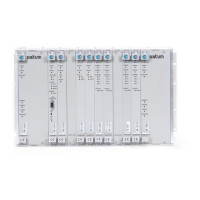12713020-002-2 Revision D – April 2004 SSU-2000 User’s Guide 155
Input Module Reference Data
1-Port and 3-Port DS1 Input Modules
Phase Measurement Averages
The Input module also maintains averages of past phase measurements including:
1000 one-second averages
1000 100-second averages
100 1000-second averages
10 10000-second averages
To account for momentary jumps in phase, the Input module uses a phase buildout
algorithm for phase jumps greater than or equal to 1 microsecond per tenth of a
second. To prevent confusing frequency offsets for phase jumps, the phase build
out algorithm does not build out more than eight consecutive samples. If the phase
is built out, the Input module sends an event message to the Communications
module.
Three-Sigma Test
The Input module uses a three-sigma test as part of the phase averaging algorithm
in order to avoid the use of erroneous phase readings. In such tests, the standard
deviation, sigma, of the phase readings is maintained. Any reading which falls more
than three sigma above or below the mean is considered erroneous.
MTIE Calculation
MTIE is a measurement of the relative noisiness of an input signal. The Input
module automatically (without user intervention) calculates MTIE for its inputs in
accordance with the specifications in (ANSI) T1.101 and reported on demand for a
24 hour period.
MTIE data is retrieved on hour boundaries, though the stop time used may be
current time. Reported time periods include 0.05, 0.1, 1.0, 10.0, 100.0, 1000.0,
10000.0, and 100000.0 seconds.
MTIE Alarms
The Input module monitors the ongoing MTIE calculations and logs an alarm if the
MTIE calculation for any of several window sizes exceeds user-set masks.
The Input module software maintains two alarm masks, each with thresholds at 10,
100, 1000, and 10000 seconds. MTIE readings which violate either mask at any
point cause an alarm at a user-set level. Refer to Changing Factory Defaults, on
page 100, for more information on setting alarm levels.
Although MTIE is continuously calculated against both clocks, MTIE alarms are
logged only if the measurements against the currently selected clock violate one of
the MTIE alarm masks.

